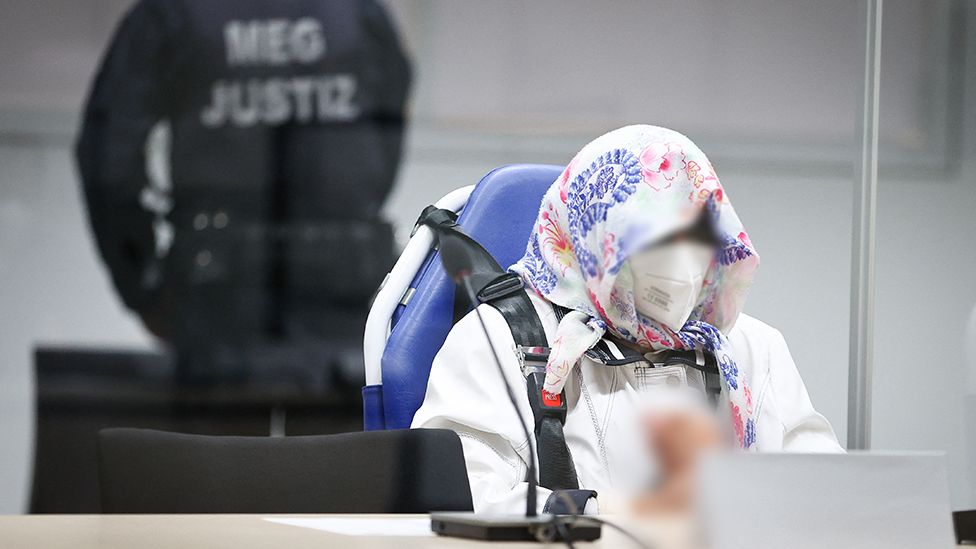A former secretary who worked for the commander of a Nazi concentration camp has been convicted of complicity in the murders of more than 10,500 people.
Irmgard Furchner, 97, was taken on as a teenaged shorthand typist at Stutthof and worked there from 1943 to 1945.
Furchner, the first woman to be tried for Nazi crimes in decades, was given a two-year suspended jail term.
Although she was a civilian worker, the judge agreed she was fully aware of what was going on at the camp.
Some 65,000 people are thought to have died in horrendous conditions at Stutthof, including Jewish prisoners, non-Jewish Poles and captured Soviet soldiers.
Furchner was found guilty of aiding and abetting the murder of 10,505 people and complicity in the attempted murder of five others. As she was only 18 or 19 at the time, she was tried in a special juvenile court.
At Stutthof, located near the modern-day Polish city of Gdansk, a variety of methods was used to murder detainees and thousands died in gas chambers there from June 1944.
The court at Itzehoe in northern Germany heard from survivors of the camp, some of whom have died during the trial.
When the trial began in September 2021, Irmgard Furchner went on the run from her retirement home and was eventually found by police on a street in Hamburg.
Stutthof commandant Paul-Werner Hoppe was jailed in 1955 for being an accessory to murder and he was released five years later.
A series of prosecutions have taken place in Germany since 2011, after the conviction of former Nazi death camp guard John Demjanjuk set the precedent that being a guard was sufficient evidence to prove complicity.
That ruling also meant that civilian worker Furchner could stand trial, as she worked directly to the camp commander, dealing with correspondence surrounding Stutthof detainees.
It took 40 days for her to break her silence in the trial, when she told the court “I’m sorry about everything that happened”.
“I regret that I was in Stutthof at the time – that’s all I can say,” she said.
Her defence lawyers argued she should be acquitted because of doubts surrounding what she knew, as she was one of several typists in Hoppe’s office.
After the war, Furchner married an SS squad leader called Heinz Furchstam whom she probably met at the camp.
She went on to work as an administrative worker in a small town in northern Germany. Her husband died in 1972.
Historian Stefan Hördler played a key role in the trial, accompanying two judges on a visit to the site of the camp.
It became clear from the visit that Furchner was able to see some of the worst conditions at the camp from the commandant’s office.
The historian told the trial that 27 transports carrying 48,000 people arrived at Stutthof between June and October 1944, after the Nazis decided to expand the camp and speed up mass murder with the use of Zyklon B gas.
Mr Hördler described Hoppe’s office as the “nerve centre” for everything that went on at Stutthof.
During his evidence he read out evidence provided by Furchner’s husband in 1954 when he said: “At the Stutthof camp people were gassed. The staff at the commandant’s HQ talked about it.”
Presiding judge Dominik Gross said it was “beyond imagination” that Furchner could not have noticed the smoke and stench of mass killing: “The defendant could have quit at any time.”
Camp survivor Josef Salomonovic, who travelled to the court to give evidence at the trial, was only six when his father was murdered by lethal injection at Stutthof in September 1944.
“She’s indirectly guilty,” he told reporters at the court last December, “even if she just sat in the office and put her stamp on my father’s death certificate.”
Another Stutthof survivor, Manfred Goldberg, said his only disappointment was in the nature of the sentence.
“It’s a foregone conclusion that a 97-year-old would not be made to serve a sentence in prison – so it could only be a symbolic sentence,” he told the BBC.
“But the length should be made to reflect the extraordinary barbarity of being found to be complicit in the murder of more than 10,000 people.”
Nazi crime cases since 2011
John Demjanjuk – jailed in 2011 for five years for his part in the murder of more than 28,000 Jews at the Sobibor death camp but released pending an appeal and died the following year aged 91
Oskar Gröning – the “Bookkeeper of Auschwitz”, sentenced in 2015 as an accessory to the murder of 300,000 Jews. He never went to jail, dying in 2018 aged 96 during the appeals process
Reinhold Hanning – former SS guard at Auschwitz convicted of helping to commit mass murder in June 2016 but died a year later aged 95 with appeals still pending
Friedrich Karl Berger – former guard at the Neuengamme concentration camp, deported to Germany from the US in February 2021 aged 95. German prosecutors dropped charges against him and his current fate is unknown
Josef S – jailed for five years in June 2022 for assisting in the murder of more than 3,500 prisoners in Sachsenhausen concentration camp. Aged 101, he is the oldest person to be convicted for Nazi-era war crimes in Germany, but because of age and ill health is unlikely to spend any time in prison
Furchner’s trial could be the last to take place in Germany into Nazi-era crimes, although a few cases are still being investigated.
Two other cases have gone to court in recent years for Nazi crimes committed at Stutthof.
Last year a former camp guard was declared unfit for trial even though the court said there was a “high degree of probability” he was guilty of complicity.
In 2020, another SS camp guard, Bruno Dey, was given a two-year suspended jail term for complicity in the murder of more than 5,000 prisoners.




